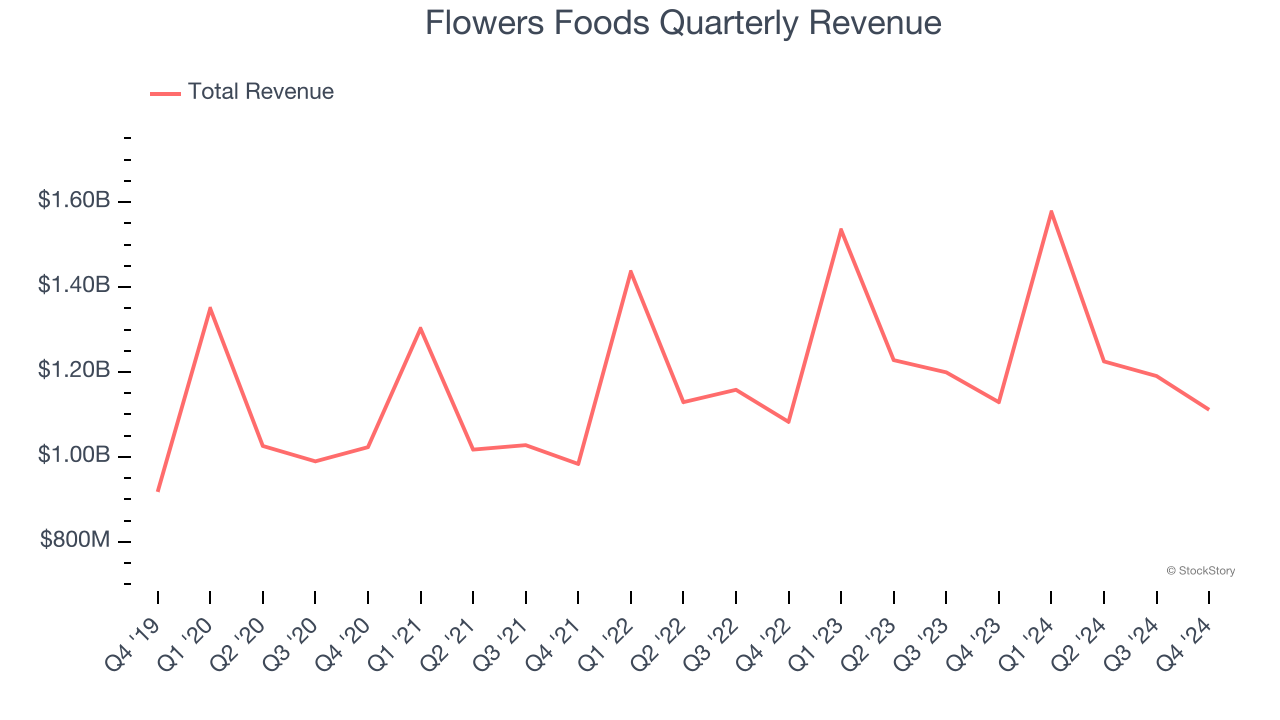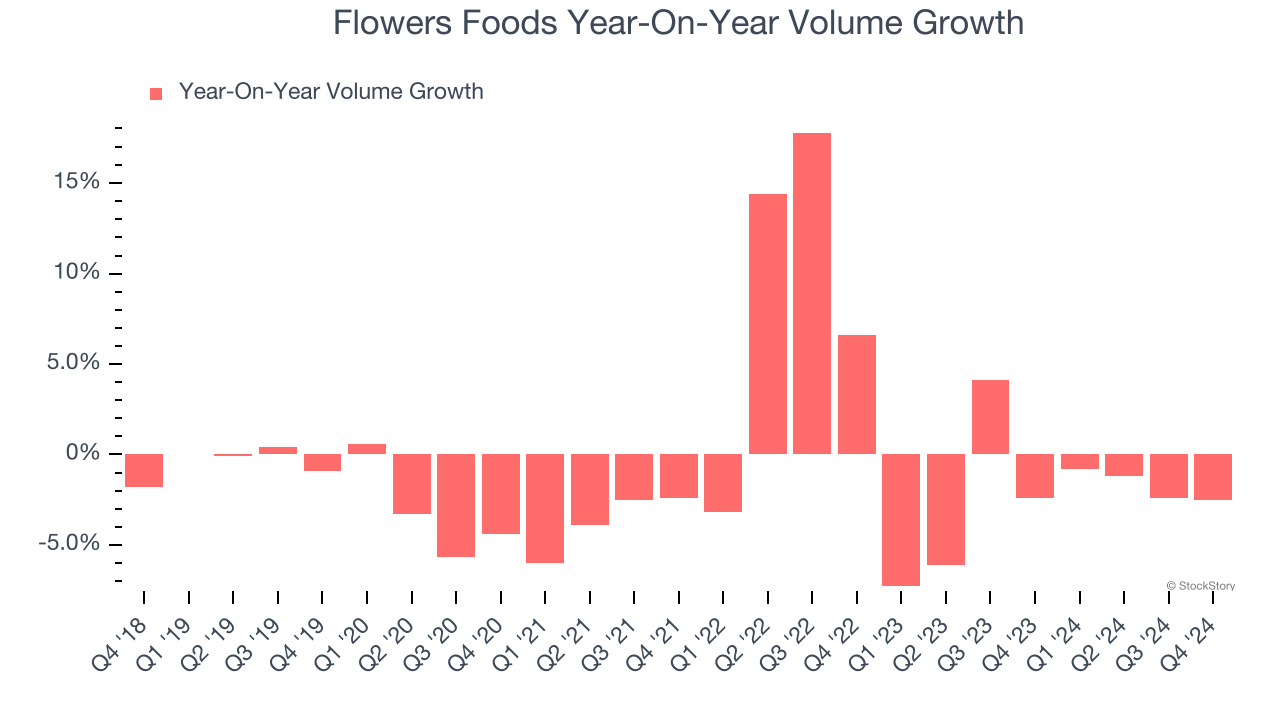
Packaged bakery food company Flower Foods (NYSE: FLO) missed Wall Street’s revenue expectations in Q4 CY2024, with sales falling 1.6% year on year to $1.11 billion. On the other hand, the company’s full-year revenue guidance of $5.45 billion at the midpoint came in 4.3% above analysts’ estimates. Its non-GAAP profit of $0.22 per share was 5.7% above analysts’ consensus estimates.
Is now the time to buy Flowers Foods? Find out by accessing our full research report, it’s free.
Flowers Foods (FLO) Q4 CY2024 Highlights:
- Revenue: $1.11 billion vs analyst estimates of $1.13 billion (1.6% year-on-year decline, 1.5% miss)
- Adjusted EPS: $0.22 vs analyst estimates of $0.21 (5.7% beat)
- Adjusted EBITDA: $102.4 million vs analyst estimates of $101.8 million (9.2% margin, 0.5% beat)
- Management’s revenue guidance for the upcoming financial year 2025 is $5.45 billion at the midpoint, beating analyst estimates by 4.3% and implying 6.7% growth (vs 0% in FY2024)
- Adjusted EPS guidance for the upcoming financial year 2025 is $1.18 at the midpoint, missing analyst estimates by 9.5%
- EBITDA guidance for the upcoming financial year 2025 is $575.5 million at the midpoint, above analyst estimates of $554.9 million
- Operating Margin: 5.5%, up from 4.4% in the same quarter last year
- Free Cash Flow Margin: 7.6%, up from 5.3% in the same quarter last year
- Organic Revenue was down 1.6% year on year
- Sales Volumes fell 2.5% year on year, in line with the same quarter last year
- Market Capitalization: $4.07 billion
"Flowers' strong execution of our portfolio strategy and cost savings initiatives drove fourth quarter and full year 2024 adjusted EPS growth in a difficult economic environment," said Ryals McMullian, chairman and CEO of Flowers Foods.
Company Overview
With Wonder Bread as its premier brand, Flower Foods (NYSE: FLO) is a packaged foods company that focuses on bakery products such as breads, buns, and cakes.
Perishable Food
The perishable food industry is diverse, encompassing large-scale producers and distributors to specialty and artisanal brands. These companies sell produce, dairy products, meats, and baked goods and have become integral to serving modern American consumers who prioritize freshness, quality, and nutritional value. Investing in perishable food stocks presents both opportunities and challenges. While the perishable nature of products can introduce risks related to supply chain management and shelf life, it also creates a constant demand driven by the necessity for fresh food. Companies that can efficiently manage inventory, distribution, and quality control are well-positioned to thrive in this competitive market. Navigating the perishable food industry requires adherence to strict food safety standards, regulations, and labeling requirements.
Sales Growth
A company’s long-term sales performance signals its overall quality. Even a bad business can shine for one or two quarters, but a top-tier one grows for years.
With $5.10 billion in revenue over the past 12 months, Flowers Foods carries some recognizable products but is a mid-sized consumer staples company. Its size could bring disadvantages compared to larger competitors benefiting from better brand awareness and economies of scale.
As you can see below, Flowers Foods’s sales grew at a mediocre 5.6% compounded annual growth rate over the last three years as consumers bought less of its products. We’ll explore what this means in the "Volume Growth" section.

This quarter, Flowers Foods missed Wall Street’s estimates and reported a rather uninspiring 1.6% year-on-year revenue decline, generating $1.11 billion of revenue.
Looking ahead, sell-side analysts expect revenue to grow 2.4% over the next 12 months, a deceleration versus the last three years. This projection doesn't excite us and indicates its products will see some demand headwinds.
Software is eating the world and there is virtually no industry left that has been untouched by it. That drives increasing demand for tools helping software developers do their jobs, whether it be monitoring critical cloud infrastructure, integrating audio and video functionality, or ensuring smooth content streaming. Click here to access a free report on our 3 favorite stocks to play this generational megatrend.
Volume Growth
Revenue growth can be broken down into changes in price and volume (the number of units sold). While both are important, volume is the lifeblood of a successful staples business as there’s a ceiling to what consumers will pay for everyday goods; they can always trade down to non-branded products if the branded versions are too expensive.
Flowers Foods’s average quarterly sales volumes have shrunk by 2.3% over the last two years. This decrease isn’t ideal because the quantity demanded for consumer staples products is typically stable. 
In Flowers Foods’s Q4 2024, sales volumes dropped 2.5% year on year. This result represents a further deceleration from its historical levels, showing the business is struggling to move its products.
Key Takeaways from Flowers Foods’s Q4 Results
We were impressed by Flowers Foods’s optimistic full-year revenue guidance, which blew past analysts’ expectations. We were also glad its full-year EBITDA guidance came in higher than Wall Street’s estimates. On the other hand, its organic revenue missed and its revenue fell short of Wall Street’s estimates this quarter. Overall, this quarter was mixed. The stock remained flat at $19.14 immediately following the results.
So do we think Flowers Foods is an attractive buy at the current price? When making that decision, it’s important to consider its valuation, business qualities, as well as what has happened in the latest quarter. We cover that in our actionable full research report which you can read here, it’s free.






